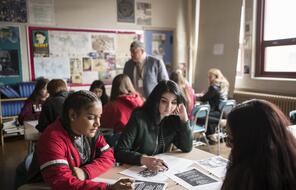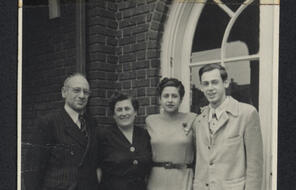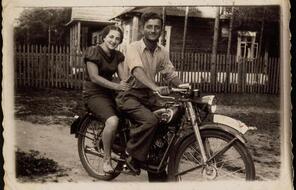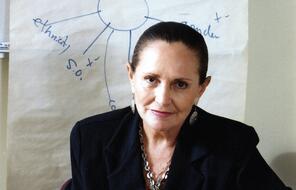The Eye of the Beholder
Subject
- Civics & Citizenship
Language
English — USUpdated
The Twilight Zone, a popular TV show that ran from 1959 to 1965, blended science fiction with fantasy and horror. The episodes often had familiar settings and featured characters that seemed quite ordinary. But the stories were far from ordinary because they took place in an imaginary world just beyond our own—“the twilight zone.” In creating the series, producer and writer Rod Serling hoped these stories would prompt thoughtful discussions of social issues. “Eye of the Beholder,” one of Serling’s most provocative episodes, probes our ideas about what is “normal” and how those ideas influence the way we think about ourselves and treat others.
The following paragraphs provide a synopsis of the story:
Meet the patient in room 307, Janet Tyler. A rigid mask of gauze bandages covers her face. Only her voice and her hands seem alive as she pleads with a nurse to describe the weather, the sky, the daylight, clouds—none of which she can see. The nurse, visible only by her hands, answers kindly but briefly.
“When will they take the bandages off?” Janet asks urgently. “How much longer?”
“When they decide they can fix your face,” the nurse replies.
“It’s pretty bad, isn’t it? Ever since I was little, people have turned away when they looked at me. . . . The very first thing I can remember is another little child screaming when she saw me. I never wanted to be beautiful, to look like a painting. I just wanted people not to turn away.”
With a consoling pat, the nurse moves away.
A doctor enters Janet Tyler’s room. We see only his hands, his shadow, his back as he looks out a window. Janet questions him with a mixture of fear and hope. When will he remove the bandages? Will her face be normal?
The doctor tries to comfort her. His voice is gentle. Perhaps this time the treatment will be successful. But he also issues a warning. He reminds her that she has had treatment after treatment—eleven in all. That is the limit. If this effort fails, she can have no more.
“Each of us is afforded as much opportunity as possible to fit in with society,” he says. “In your case, think of the time and effort the state has expended, to make you look—”
“To look like what, doctor?”
“Well, to look normal, the way you’d like to look. . . . You know, there are many others who share your misfortune, who look much as you do. One of the alternatives, just in case the treatment is not successful, is to allow you to move into a special area in which people of your kind have congregated.”
Janet twists away from the doctor. “People of my kind? Congregated? You mean segregated! You mean imprisoned! You are talking about a ghetto—a ghetto for freaks!” Her voice rises in a crescendo of anger.
“Miss Tyler!” the doctor remonstrates sharply. “You’re not being rational. You know you couldn’t live any kind of life among normal people.” His words are harsh, but his voice is sad and patient.
Janet refuses to be mollified. “Who are these normal people?” she asks accusingly. “Who decides what is normal? Who is this state that makes these rules? The state is not God! The state does not have the right to make ugliness a crime. . . . Please,” she begs. “Please take off the bandages. Please take them off! Please help me.”
Reluctantly the doctor agrees, and the staff prepares for the removal. Bit by bit, he peels the gauze away. She sees at first only the light, then the shadowy forms of the doctor and nurses. As the last strip of gauze comes off, the doctor and nurses draw back in dismay. “No change!” the doctor exclaims. “No change at all!”
Janet Tyler gasps and raises her face. She has wide-set eyes, delicate brows, fine skin, and regular features, framed by wavy blonde hair. She begins to sob and struggle away from the nurses.
“Turn on the lights,” the doctor orders. “Needle, please!”
As the lights come on, the doctor and nurses are clearly visible for the first time. Piglike snouts dominate their lopsided, misshapen features. Their mouths are twisted, their jowls sag.
Janet runs through the hospital in a panic, pursued by nurses and orderlies. She passes other staff and patients. Each face is a little different but all share the same basic pattern—snouts, jowls, and all. She flings open a door and freezes in sudden shock. The doctor and another man are in this room. She sinks down by a chair and hides her face in fear.
“Miss Tyler, Miss Tyler, don’t be afraid,” the doctor urges. “He’s only a representative of the group you are going to live with. He won’t hurt you. . . . Miss Tyler, this is Walter Smith.”
Walter Smith steps forward, and Janet Tyler cringes away. He too has regular features, lit by a friendly smile. A stray lock of dark hair curls over his forehead. “We have a lovely village and wonderful people,” he tells Janet. “In a little while, a very little while, you’ll feel a sense of great belonging.”
She looks at his face. “Why do we have to look like this?” she murmurs.
“I don’t know, I really don’t,” he replies with sadness. “But there is a very old saying—beauty is in the eye of the beholder. Try to think of that, Miss Tyler. Say it over and over to yourself. Beauty is in the eye of the beholder.”
He holds out his hand to her. Slowly, hesitantly, she takes it, and they walk away together, through a corridor lined with pig-faced spectators. 1
Connection Questions
- What is the “twist” in this episode of The Twilight Zone? What might creator Rod Serling be trying to communicate with this unexpected twist in the story?
- Where do we get our ideas about beauty? How do we learn what is normal?
- How would you adapt “Eye of the Beholder” to today’s world? What changes would you make in the story?
- 1Marc Scott Zicree, The Twilight Zone Companion, 2nd ed. (New York: Bantam Books, 1989), 144–45.
How to Cite This Reading
Facing History & Ourselves, “The Eye of the Beholder”, last updated August 2, 2016.













